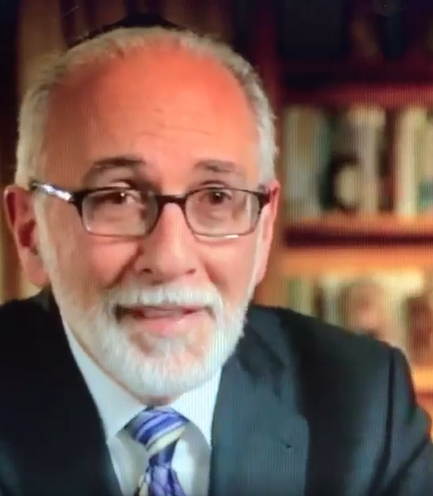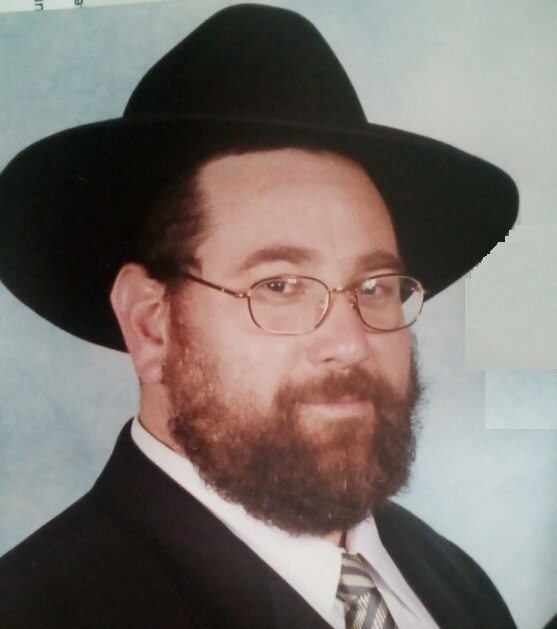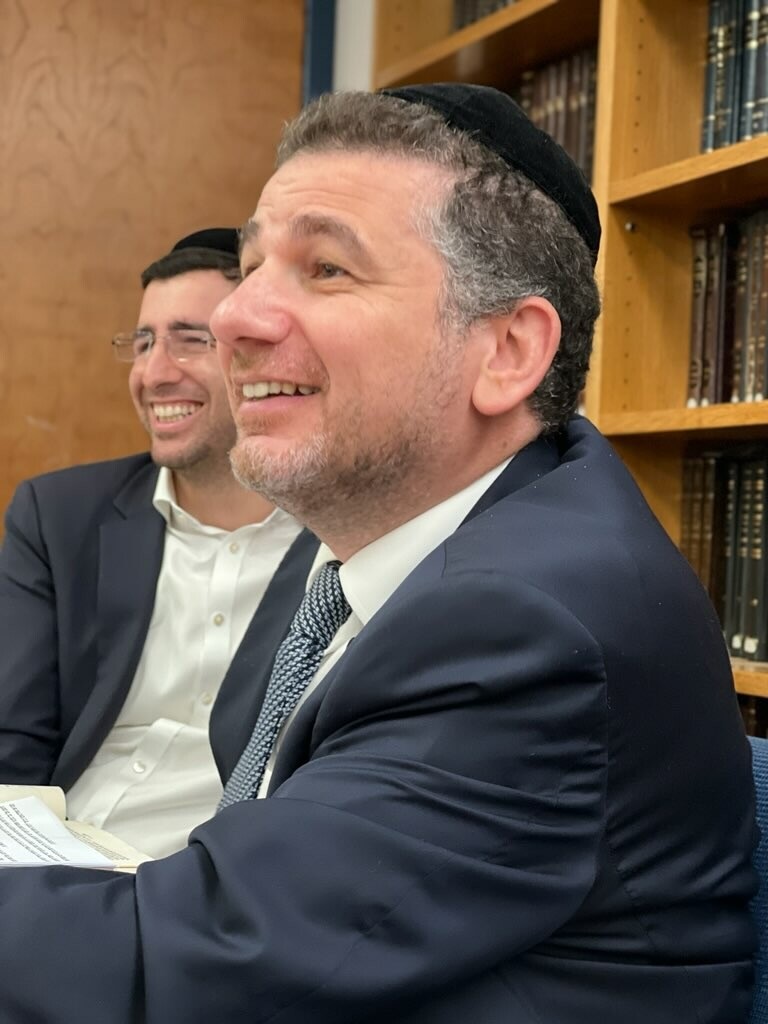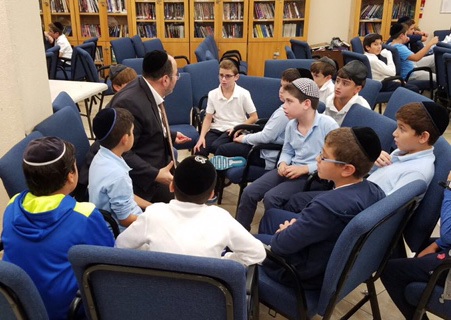Ohev Hashem Shaare Zion
by Rabbi Binyomin Zev Karman

Rav Chisda said, “What is meant when it is written (Tehillim, 87:2), ‘Oheiv Hashem Shaare Zion mikol mishkenot Yaakob − Hashem loves the gates of Zion more than the all the sanctuaries of Yaakov’? [The verse means] Hashem loves the gathering places distinguished in halachah more than synagogues and study halls.” (Berachot, 8:a)
Rabeinu Yonah (ad loc) explains that the synagogues, where people come to pray, have a high measure of holiness, as do the study halls where people come intermittently to study and hear drashot. However, the places where people come on a constant basis to study Torah is compared to the Bet Hamikdash, and Hashem has a greater affinity for it than the other holy houses of prayer and occasional study.
Congregation Shaare Zion, the flagship synagogue of the Syrian-Jewish community in Brooklyn, has a long, storied history. Completed in 1960, it seats thousands of congregants, who come together each week to pray in their time-honored tradition and to socialize with extended family along with generational friends.
Shaare Zion was built to function as a k’nees, or bet knesset, along with an adjoining social hall to host celebrations of weddings and other joyous gatherings. On Shabbat, the various Rabbis of the congregation delivered moving drashot which inspired the upkeep and strengthening of a community which excelled in their charitable giving in support of noble causes.
Many American Jews of Syrian descent had been raised in an atmosphere that being a businessman was in conflict with being a ben Torah. In the late 1980s, Hacham Yom Tob Yedid, zt”l, arrived in New York from Aleppo (Chaleb), Syria, with a group of Jews who had preserved the heritage and traditions of Chaleb. His arrival heralded the start of a revolution of sorts, as he showed that Torah learning in a serious manner was the way Judaism was practiced in the old country, and the way it was currently being practiced in New York was not the traditional track of Syrian Jewry.
Around 1995, Hacham Yom Tov Yedid’s son, Rabbi Meir Yedid, began teaching Torah on a more serious level to a group of laymen. When some countered that it was not possible to remain in business if they would dedicate a substantial allotment of their time to Torah study, Rabbi Meir Yedid refuted them by pointing out that he ran a successful business and indeed devoted a significant amount of time to learning Gemara on an intensive level.
In 1995, Hacham Baruch Ben-Haim, zt”l, a senior Rabbi at Shaare Zion and the son-in-law of Hacham Yaakob Kassin, zt”l, Chief Rabbi of the Syrian community, founded the Torah Center in Shaare Zion, which encouraged the members to join for various classes of Torah.
“Hacham Baruch was my Rabbi since seventh grade in Magen David Yeshiva,” Rabbi Raymond Beyda recalled. “We would pray together and have Torah classes, but it was in a very small group. Unfortunately, at that time, shul was where you came to pray, you got a bagel and then you were off to work. Shul as a place of learning was virtually non-existent; it was a place to go if you wanted a minyan. There were some classes, lectures about the parashah and halachah, but the actual amount of ‘book learning’ was almost nil.
“One morning, Hacham Baruch called me aside and said, ‘If we do not have serious Torah learning, there will be no Shaare Zion twenty-five years from now.’ At the time, the building was under construction for an expansion, and Hacham Baruch wanted us to develop a Torah Center. When I suggested we start next year, he said, ‘No! Immediately!’ So we began announcing at the few minyanim in Shaare Zion that we have a Torah Center, and we began building his dream.
“We initiated something we called ‘First Tuesday’ where, on the first Tuesday of each month, we invited all the men and women of the community to come to the Dome in Shaare Zion for a lecture. I brought in some of the top speakers available: Rabbi Yissocher Frand, Rabbi Pesach Krohn, and others. We filled the place, and we kept announcing that we were going to have classes in English, Hebrew and Arabic. The groups would be in halachah and hashkafah, for men, women and children, and it would be called the Shaare Zion Torah Center. This continued from February until June, because in the summer the entire community disbanded and moved to the Jersey Shore.”
Morris “Mershy” Franco was a dedicated leader of the community, and he followed every word of Hacham Baruch. When the Rabbi said there should be a Torah Center, he arranged that a room in the new lower level should be set aside for it. “One day, Mershy took me behind the curtains of the construction and led me to the basement. He showed me a room which is now the breakfast room, and said, ‘This is your Torah Center.’ The room had bare walls with no bookcases, and the lighting was with spotlights. I saw a large area nearby and asked what that space was for. Mershy responded, ‘That is for the caterer, for small events like a brit milah or engagement party.’ To which I replied, ‘No, Mershy, that is our Torah Center.’ Mershy expressed some doubt, asking me if I thought we could ever fill it. I said we would, and today, as all can see, it is bursting at the seams. There are tables of people learning not only in all the rooms, but there are also even tables lining the halls, and the walls are lined with bookcases filled with sefarim which are constantly being used.”
When they returned from the summer, the building was finished, and we hired six avreichim for our Torah Center. The word kollel could not be used at the time, because there would have been resistance and pushback from segments of the community, so they called it the nighttime midrash program, a sort of pareve name.
Hacham Yosef Harari-Raful, shlita, today the Rosh Yeshivah of Ateret Torah, had been one of the Rabbis in Young Shaare Zion before launching the revolution of Ateret Torah which transformed the education of the youth of the Syrian community. As a former Rabbi in Shaare Zion, his school and shul are considered offshoots of the flagship synagogue. Hacham Yosef’s son, Rabbi Aharon Haim (Ronnie) Harari-Raful, zt”l, began a group with a handful of people, and Hacham Baruch had his group of eight to ten people. Rabbi Leon Gindi was brought in to deliver shiurim in Arabic.
“Rabbi Gindi was an accountant, but was a very learned and personable man. We supplied him with a table, and for the first week he came every morning,” Rabbi Beyda related. “At the end of the week, he resigned. He said, “You told me I would be giving classes, but there are no students.’ I told him don’t worry, they’re coming. He agreed to stay on one more week, but if it did not materialize, he would quit because he could not take money from the tzibbur if no one attends.
“On Thursday, the next-to-last day, one man walked in and looked around. He saw Hacham Baruch with his eight men, and Rabbi Ronnie Raful with his group, and he said, ‘I thought you said you have classes in Arabic. I pointed to Rabbi Gindi, and said, ‘Yes, over there!’ Today, Rabbi Gindi is the Rabbi for the Ararbic-speaking members of the Torah Center, teaching four different masechtot b’iyun!”
While the Torah Center began attracting some of the older people, the younger members of the community were not attending, and Rabbi Beyda set to work to do something to attract them as well. They had the six avreichim with six empty tables, and they asked permission to purchase Gemarot for themselves, saying that if there were no students, at least we can learn with each other as a group.
“I told them they could buy the Gemarot, but assured them that the people were coming,” Rabbi Beyda continued. “A few nights later, in walked twelve boys who had learned in Ateret Torah and had gone to work, and they announced, ‘I thought you have classes here.” I said, ‘We do!’ They became the core who started what exists today, and they remain the leaders of the Torah Center to this very day.”
At the onset of the Torah Center, the administration agreed to allow them to learn until 10:00 p.m., then pray Arbit and leave the premises by 10:15 when the maintenance crew locked up. “Those Ateret boys told me, ‘You’re in business quite a while, and we are just beginning. We would like to have a class on business halachah.’ I taught a class in the Dome every Monday night from 8:30 to 10:00, and it was suggested we learn each Monday evening from 10:15 until 11:00. We had to convince the committee to pay the maintenance crew overtime and allow us to remain after Arbit,” Rabbi Beyda related.
“Rabbi Ronnie Harari-Raful went on to galvanize the campaign to transform the edifice into a makom Torah by organizing a network of nighttime study groups and shiurim for the members of the community. He came to me and asked permission to purchase a bookcase. Until then, we stored our books on a ledge in the room, and I authorized the purchase. Since he had Frankel’s Seforim Shranks coming down to measure, I told him he might as well buy two, since there was room for two. That got filled, and we purchased another one, and then another. Look around today and you will see the rooms and hallways are filled wall-to-wall, ceiling to floor, with bookcases filled with sefarim!”
Rabbi Raymond Haber, a havruta of Ronnie, was drafted to head the program, and it catapulted the success beyond belief. Boys and men, many with limited background in Gemara, began learning in earnest, and before long they were transformed into bnei Torah and were able to open a gemara and learn on their own.
“The year after he began the shiurim in the Torah Center, my brother-in-law Ronnie hired me to come in from Lakewood and deliver a shiur on Gemara Kiddushin,” said Rabbi Moshe Laniado. “We began at the beginning and went straight through the entire Masechet Kiddushin from cover to cover, making a grand siyum when we completed it.
Rabbi Leon Gindi once asked Rabbi Beyda to request permission from Hacham Baruch that he be allowed to use a side room each morning. He delivered a shiur in the mornings, and there was a suggestion that he have an early minyan before the learning, and another minyan after the learning, and so would be able to attract a double contingent of people to learn with him in between the two minyanim. “Tell Hacham Leon in my name that if he can attract even one more student to learn Torah, he has permission to do whatever is necessary,” was Hacham Baruch’s reply.
Slowly but surely, the attendance at the numerous shiurim increased, and the youth of the community started coming on a nightly basis. Today, the younger boys come at an earlier hour and review what they learned that day, do their homework, and then head home and make room for the older boys, who arrive after a longer day in school but still spend several hours in intensive learning. It is difficult to find an empty seat.
As time went on, the original group told Rabbi Beyda that in order for them to marry like-minded spouses, he would need to begin classes for the girls. “We are growing, and we need to find spouses who are growing as well,” they said. Rabbi Beyda set in motion a program for girls, and the first Tuesday night some forty girls attended. The program ran for several years, and then branched out with classes for women running from 10:30 a.m. until 1:30 p.m. Eight teachers taught the women’s classes, which were filled with girls and women seeking growth as they learned halachot of Shabbat, family life, parashah and hashkafah. Before they broke for the summer, they threw a gala party which caught the attention of the community women. Before long, everyone wanted to be part of the classes, and they expanded tremendously.
“The teachers were the students of Rebbetzin Zehavah Braunstein, a”h, who was the principal of Ateret Torah Bet Yaakov High School, and today many of them are teaching and leaders of the women in the community,” Rabbi Beyda said with pride. “We had two hundred women coming in daily for classes. These women got turned on to Torah, and it changed not only them but influenced their entire family. Today, we have second and third generations of Torah learners.”
About ten years ago, Rabbi Meir Yedid, now the Rabbi in the Dome minyan of Shaare Zion and Rosh Yeshivah in Yeshivat Derech Eres (YDE), wanted his students and the youth of the community to dedicate some of their free time to Torah study. However, some felt that if an extra-curricular program was tied to the school it would be impeded by those who felt that being in school for another period of time after school hours would be too much.
Instead, he envisioned an evening program which would use the Torah Center, and would invite boys from all the schools in the community to converge on Shaare Zion each evening to study, do homework, or attend a shiur of their choice. Nothing is mandatory; attendance is completely voluntary.
The groups of younger boys arrive at 6:00 p.m. and fill the lower level of Shaare Zion for about two hours. Some learn themselves or do homework with the assistance of their friends or the Rabbis, and some attend Mishnayot classes on various levels offered by the Rabbis of the Torah Center. As the younger boys file out between 7:30 and 8:00 p.m., the older boys begin arriving, packing into every nook and cranny as the sounds of Gemara permeate the numerous rooms. Rabbis circulate and offer help and encouragement. “If you would just hear the clamor without seeing the faces, you might think you are in a bet midrash filled with post-high-school boys. But these are actually elementary-school-age boys who come of their own volition to imbibe the Torah atmosphere. No one is forcing them to come, yet they know that by being here, they will find a wonderful environment in which to spend their evening,” Yosef Zafrani said. “There are approximately six hundred boys a week who attend the Torah Center.”
“As a young boy, I attended the Torah Center,” said Rabbi David Nakash, a kollel yungeman presently learning at Ateret Torah. “I was approached by someone in the Torah Center who told me, ‘You benefitted from the programs as a child. Now it is time for you to give back to the community.’ I could not argue with that, and I now spend evenings in Shaare Zion helping youngsters experience the joy of learning Torah just as I did as a young boy.”
Rabbi Nakash also runs Bnei Aliyah, one of the numerous minyanim for the younger men of the community in the lower level of the annex building of Shaare Zion each Shabbat. “The group that he leads has an assortment of men from various backgrounds, but there is no stigma whatsoever amongst the individuals,” said Yosef Zafrani. “We are all in this together, willing to help each other grow at the pace that is right for them. The Torah Center generates a transformation not only in the men who attend the classes, but their entire families are elevated.”
Tuesday evening is Havruta Night, where the regular attendees are encouraged to “Bring a Buddy” and introduce them to intensive Gemara study. The halls of Shaare Zion are lined with extra tables as the newcomers join the old hands in studying a sugya of Gemara in depth. Pages are copied to supply each pair with all the material they need, and the contagious atmosphere leaves all longing for another session. Before long, the newcomers are old hands themselves, inviting another new crop to join them in their pursuit of Gemara learning.
“Rabbi Yedid has shown the community that being a businessman is not a contradiction to being a ben Torah,” Yosef Zafrani said. “He has produced a cohort of men who have made Torah study an important part of their lives. These same people who used to be in the office first thing in the morning are now staying to learn extra each morning after Shaharit, and some don’t get to the office until noon or later.”
Never looking to rest on their laurels, the administration of Shaare Zion detected a need to create a program for high school graduates who have gone on to study in college. “By its very nature, the college culture is a danger to the spiritual level of those who attend, and it is easy for them to slip in their observance,” Yosef said. “To answer this need, Shaare Zion began Kesher, where a young man who is involved in the Torah Center will visit college campuses which community youth attend and develop a relationship with the college students through Torah Study and other events. Before long, these same students are proudly displaying their kippah and tzitzit as they strengthen their commitment to Torah and Judaism.”
Today, the Shaare Zion Torah Center has a staff of over one hundred Rabbis delivering shiurim on multiple levels, which allows the participants to find a group which fits his style, schedule and level without imposing any stigma. From 5:00 a.m. until late at night, the rooms of the Torah Center are humming with the sounds of people learning, many who began with little or no experience but filled with a desire to grow. With a successful Moments fundraising drive this past June, plans are in the works to expand the staff to 130 Rabbis.
“A Rabbi who fundraises for an institution in Israel came to me and said that he travels the world and visits dozens of shuls across the globe,” Rabbi Raymond Beyda recounted. “I see the men in other shuls entering each morning with their kuratcha (tallit bag) tucked under their arms. In Shaare Zion, it seems no one has a kuratacha, since everyone is entering the building with a gemara tucked under their arms as they head to learn each morning.” This is what the Shaare Zion Torah Center is all about. This is the dream of Hacham Baruch Ben Haim coming to fruition, and indeed it did bring new life to Shaare Zion. On Shabbat, instead of two hundred people praying there are two thousand people praying in the twelve minyanim in the shul. Each minyan has its own flavor, and the Rabbis and members are growing together. Even on Shabbat afternoon, people return at 3:00 p.m., after barely finishing lunch, and they spend the afternoon learning Torah at Shaare Zion. I believe the Torah Center is the reason the community is growing, both physically and spiritually, by leaps and bounds.”
The idea of a Torah Center, with round-the-clock learning for all ages, has taken root in several other shuls in the area, transforming them and the entire Syrian community into a Torah based kehillah.
Oheiv Hashem Shaare Zion − Hashem loves Shaare Zion.
This article appeared in the SEFARDIC HERITAGE IN AMERICA SUCCOT SUPPLEMENT





This article originally appeared in Hamodia’s Sefardic Heritage in America – Succos Supplement
To Read The Full Story
Are you already a subscriber?
Click "Sign In" to log in!

Become a Web Subscriber
Click “Subscribe” below to begin the process of becoming a new subscriber.

Become a Print + Web Subscriber
Click “Subscribe” below to begin the process of becoming a new subscriber.

Renew Print + Web Subscription
Click “Renew Subscription” below to begin the process of renewing your subscription.
















